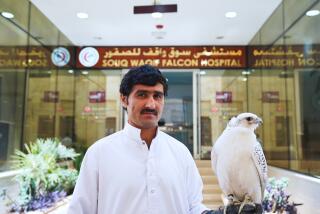Cairo Hospital Saves Beasts of Burden and Livelihoods
- Share via
CAIRO — It’s a typical Cairo scene: a white ambulance making its way slowly through clogged traffic, with most drivers ignoring its mission of mercy and refusing to move aside.
But this ambulance is different--it’s a pickup truck, actually--and the patients are two donkeys, one blind and the other with a broken leg, being taken for treatment at the Brooke Hospital for Animals.
Since 1934, the charity hospital has been treating working animals--mainly horses and donkeys--and it continues to have plenty of patients because animals still do all manner of jobs in Egypt.
Senior veterinarian Salah Wahib says the hospital’s goal is to take care of the animals of poor Egyptians.
“Visibly we are treating the animals, but in fact we are helping the poor,” he said.
Tarek Abdul-Sattar Mohammed, 24, for one, is glad. He wouldn’t have been able to pay for treating his donkey, which pulls the cart from which he sells grains and seeds to make a living.
“It is something that brings me bread, and I should take care of it,” he said on a visit to the donkey, whose blotchy coat comes from a skin disease.
Brig. Hassan Sami, head of the hospital, said 4,352 animals were treated in the hospital in 1997 and 22,296 others were handled in outpatient programs.
The hospital’s late founder, Dorothy Brooke, the wife of a British army general, got the idea for the program when she saw onetime British military horses being treated badly as work animals in Egypt. The horses had been sold off by the army after World War I.
She began collecting money from friends to buy the horses. Old, tired horses were put to sleep; those in good health were sent to Britain by ship.
Later, the hospital’s work was expanded to treating working animals in general. It now has branches in four other Egyptian cities, with plans for two more, and also has programs in India, Pakistan and Jordan.
In Egypt, the need for Brooke’s services remain obvious. The government has no figures for the number of working animals, but they are believed to number in the tens of thousands.
Donkeys and oxen still draw plows on small farms. In Cairo’s exhaust-choked streets, donkeys and horses haul rickety carts piled with all types of goods, and horses draw “hantours,” covered carriages that carry tourists along the Nile.
Veterinarian Wahib, standing next to a horse with about a 20-inch stitched wound in a hind leg, said the animal was hit by a car, one of the main causes of injury. Another is that owners simply work their animals too hard.
Wahib said often the animals most need rest and good food, noting the average stay is three weeks. He recalled one horse that was picked up by its owner from the hospital and came running back a short time later.
Like any modern hospital, Brooke has a lab and X-ray room. Each animal entering the hospital is given a file number--stamped on its hoof.
More to Read
Sign up for Essential California
The most important California stories and recommendations in your inbox every morning.
You may occasionally receive promotional content from the Los Angeles Times.













